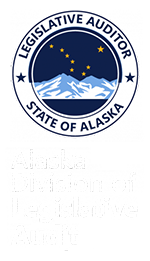Summary: The report notes areas in which the department satisfactorily administers programs as well as reveals a number of administrative processes and functions which need improvement to better meet the needs of Alaskans.
Click here for the table of all findings for improving administrative functions
Click here for the table of all recommendations for improving administrative functions
Key Findings for Administrative Functions
- The department’s referral and placement policies for child and adolescent residential services are effective and efficient thanks in part to the 2005 Bring the Kids Home Initiative.
(Recommendation 5.3.5)
- Abuse of prescription opioid narcotics is both a major behavioral health concern as well as a significant source of fraud and abuse in the health care system. Alaska’s current prescription drug monitoring law creates barriers that restrict DHSS and the Department of Law from accessing prescription drug data and using it to identify patient “doctor-shopping” and other prescribing practices that are potentially fraudulent or abusive.
(Recommendation 13.1.8)
- The Department of Health and Social Services (DHSS or department) did not submit a list of 10 percent reductions in general funded budget. Instead, it offered a proposal for reductions drafted originally in response to the governor’s request for five percent and eight percent program reductions.
(Recommendation 7.1.2)
Key Recommendations for Administrative Functions
- Reforming staffing policies and practices at the Alaska Psychiatric Institute (API), including more competitive hiring and retention efforts, could significantly improve the quantity and quality of care without increasing costs.
(Recommendation 2.4.1)
The state has a workforce shortage of qualified psychiatrists. This problem is accentuated at API by its sub-optimal personnel policies that maintain staffing levels in the short term, but ultimately hurt long-term workforce development and increase administrative challenges. For example, shortages both in psychiatrists and in psychiatric nursing staff have led API to establish mandatory staff overtime. This policy not only harms the hospital’s competitiveness in hiring and retention, but it also contributes to a worrying rise in workplace injury rates at the hospital. High turnover rates and physician vacancies subsequently force the hospital to contract with locum tenens (or temporary) agencies costing twice as much as a state-employed physician. The policy creates quality and continuity of care issues as well as budgetary inefficiencies. Overtime wages and locum tenens salaries are more expensive than regular wages and full-time salaries with benefits. By relying on mandatory overtime and locum tenens psychiatrists to staff API, the department experiences higher staffing costs and delivers a lower quality of care.
- The department should develop a Medicaid behavioral health rate structure that covers provider costs, incentivizes quality, and minimizes administrative burden.
(Recommendation 3.0.8)
Since 2007, the department has funded a larger proportion of mental health and substance abuse services through Medicaid reimbursement rather than grant awards. However, the Medicaid reimbursement rates have not been updated since 2007 and are insufficient to cover the costs of needed services. DHSS supplements the Medicaid funding with state-funded grants. By revising rate structure, a greater share of the service costs will be paid for by federal funds.
- The department should incorporate performance measures that are more appropriately outcome-oriented.
(Recommendation 4.3.4)
Outcome-oriented measures are well represented among the Division of Behavioral Health’s performance measures, but many rely on consumer perceptions of the quality of care rather than more objective indicators of recovery, such as the ability to secure stable housing or improved employment status. The department should revise the performance measures to include additional, more robust outcome-oriented measures along these lines.
- The department should align the performance measurement for community providers, with the measures used in accreditation requirements as much as possible.
(Recommendation 4.3.6)
DHSS mandates that behavioral health service providers be accredited by a division-approved, private, non-State organization that assesses the provider for meeting best practice and quality of care standards. DHSS also requires behavioral health providers undergo additional evaluations by DHSS staff. Since providers are already required to be evaluated by certain quality indicators in the accreditation process, DHSS should match these accreditation measures within its performance management system. Holding providers to two separate sets of standards is confusing and costly, and places additional burdens on providers and the department.
- The department should improve coordination efforts with the Department of Corrections (DOC) to ensure consistency in treatment programs and protocols for individuals exiting correctional facilities.
(Recommendation 5.5.5)
DOC is the largest provider of behavioral health services within Alaska. Developing coordinated behavioral health treatment programs available within the correctional system based on the same principles and using the same evidence-based practices as those services available within the community would provide continuous care for individuals exiting the correctional system. Continuity and minimal disruption of behavioral health care eases the reentry process and promotes a successful transition from the correctional system into the community.

